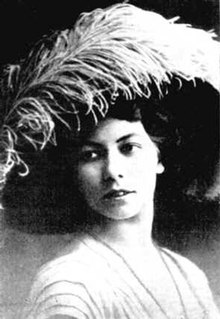Bronislava Nijinska
| Bronislava Nijinska | |
|---|---|
 |
|
| Native name | Бронисла́ва Фоми́нична Нижи́нская |
| Born |
Bronislava Fominichna Nizhinskaya January 8, 1891 Minsk, Russian Empire |
| Died | February 21, 1972 (aged 81) Pacific Palisades, California |
| Occupation | ballet dancer, choreographer, ballet teacher |
| Spouse(s) | Alexandre Kochetovsky Nicholas Singaevsky |
| Children | Leo Kochetovsky, Irina Nijinska |
| Relatives | Vaslav Nijinsky (brother) |
| Awards | National Museum of Dance's Mr. & Mrs. Cornelius Vanderbilt Whitney Hall of Fame, 1994 |
Bronislava Nijinska (Belarusian: Браніслава Ніжынская; Polish: Bronisława Niżyńska; Russian: Бронисла́ва Фоми́нична Нижи́нская, Bronislava Fominichna Nizhinskaya) (January 8, 1891 [O.S. December 27, 1890] — February 21, 1972) was a Polish dancer, choreographer, and teacher. Nijinska played a leading role in the pioneering movement that turned against 19th-century Classicism, which paved the way for neoclassical works to come. A breakthrough came in 1910, when she created her first solo, the role of Papillon in Le Carnival.
Nijinska was born in Minsk, the third child of the Polish dancers Tomasz Nijinsky and Eleonora Nijinska (maiden name Bereda). She was the younger sister of the renowned dancer Vaslav Nijinsky (Wacław Niżyński). Early on in life, Nijinska learned folk dances at home. Nijinska’s parents were professional dancers as well. They danced with the Warsaw Wielki Theatre. Her parents taught her Polish, Hungarian, Italian, and Russian folk dances. Additionally, her father taught her some acrobatics which she later incorporated into some of her choreographic works. She was four years old when she made her theatrical debut in a Christmas pageant with her brothers in Nizhny Novgorod. Nijinska trained with Enrico Cecchetti before joining the Imperial Ballet School in 1900. She was a student there until 1908 and was taught by Nicolai Legat and Mikhail Fokine.
In 1908, Nijinska joined the Imperial Ballet (Also formerly known as the Mariinsky Ballet and Kirov Ballet) following in her brother's footsteps. In her first year, she performed Fokine's Les Sylphides, where she directly experienced Fokine's choreographic vision. Both she and Nijinsky left Russia in 1909 to join Diaghilev's Ballets Russes.
...
Wikipedia
